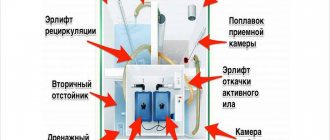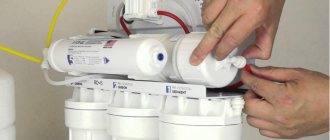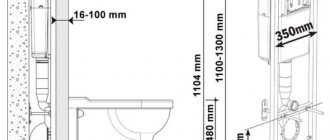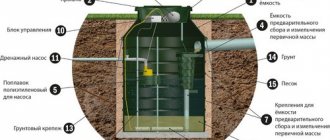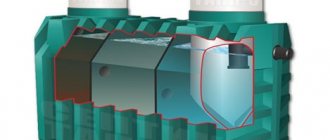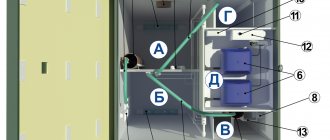Characteristics and advantages of installing Topas
Installing a Topas septic tank with your own hands in a country house is justified, since the station is characterized by:
- high cleaning efficiency;
- economical power consumption;
- absence of noise during operation;
- compactness;
- tightness;
- no need for special care during operation.
You can choose a specific model of the Topas bio-treatment station for a specific house, based on the number of people permanently residing in the building and coming to visit. So, for example, the Topas-8 septic tank is capable of serving a family of 8 members, and Topas-5 - of 5 people. The equipment will last a long time if the rules for its operation are followed. To do this, before installing the Topas septic tank, you should carefully study the instructions.
From it you can find out what it is strictly forbidden to throw away and flush into the sewer:
- vegetables that have become unusable;
- sand and other building materials;
- rubber, bags, cigarette filters and other products that are not biodegradable;
- water containing oxidizing agents;
- liquid with a high content of chlorine compounds;
- medicinal preparations;
- automotive consumables.
At the same time, discharge into the Topas septic tank is permitted:
- toilet paper;
- water containing washing powder;
- used liquid for kitchen, bath and shower needs.
Operating principle of the Topas septic tank
The design of the station is different in that it has a single compact body.
Thanks to this, installing a Topas septic tank with your own hands is an easy job. It was already said earlier that wastewater treatment in it is carried out by bacteria, the nutrient medium of which is organic waste and oxygen. Microorganisms decompose sewage into safe elements. There is no need to replenish stocks of biological products, since they reproduce on their own. Inside, the Topas cleaning station is divided into 4 compartments. Each of them performs its own function. In a separate plastic bin there are two compressors that support the vital activity of bacteria - as a result of which the decomposition process occurs faster, because the liquid is saturated with oxygen.
Subtleties and nuances of wise choice
The commercially available models of this cleaning station differ in power. Thanks to the wide model range, you can choose a design whose parameters will fully meet the customer’s needs.
For furnishing private houses, models with a numerical index of 5.8 and 10 are most often chosen. The Topas-5 model has a capacity of 1 cubic meter and is designed for a salvo discharge within 0.22 cubic meters.
The productivity of Topas-8 is 1.5 cubic meters, it copes with a salvo release in the region of 0.44 cubic meters. The Topas-10 model successfully operates with a productivity of 2 cubic meters, and its salvo release volume is 0.76 cubic meters. meters.
The numerical indicator in the name of each model indicates the maximum number of users for which the local treatment station is designed
Topas-5 is chosen for arranging an autonomous sewer system for small houses with no more than five residents. This does not take into account a large number of plumbing fixtures.
For large cottages, the number of households in which reaches 8 people, choose a septic tank with increased productivity - the Topas-8 model. If you plan to connect several washing machines and install a jacuzzi in addition to a shower cabin, choose the model of the following modification Topas-10.
Each model has two modifications, differing in height:
- Standard - involves inserting a sewer pipe at a depth of 0.4-0.8 meters.
- Long - for deepening a sewer pipe up to 0.9-1.4 meters.
For areas where the geological section is represented by soils with low filtration properties, it is worth choosing models equipped with a pump. They provide a forced system for the removal of treated wastewater to the disposal site. Such modifications are marked “PR”.
Features of the operation of septic tank chambers
First compartment
. All sewage flows into it through a pipeline. A float switch is located at a certain height. When the chamber fills, it transmits a signal to the first compressor. In automatic mode, the wastewater is redirected to the second compartment. In this case, all large fractions remain at the bottom of the first chamber. At the entrance to the second part of the septic tank, a coarse filter is installed that can even catch hair.
Second compartment (aeration tank)
. It contains pre-filtered wastewater. They feed on bacteria that break down organic large fractions. In order to speed up the processing process, the compressor supplies oxygen to the chamber. The effluent begins to accelerate its movement, mixing with activated sludge. In this process, sludge plays a key role, since it serves as a kind of filter that connects solid particles and foreign bodies that accidentally fall into the septic tank.
Third compartment
. Liquid waste, agitated by the activity of bacteria, flows into the next chamber. It is assigned the function of a secondary settling tank. The third part of the treatment plant is equipped with a pyramid. In this compartment, the wastewater is separated into water and sediment. Old sludge, together with binding components, sinks to the bottom, and fresh and lighter sludge is sent to the first chamber for the purpose of additional purification.
Fourth compartment
. This chamber is designed for water purification. The clarified liquid, passing through the top of the stilling pyramid located in the third compartment, enters the last, fourth part of the installation. There is a hole in it at a certain height, thanks to which the water completely leaves the septic tank.
Provided that the inflow into the first chamber is weak, deeper cleaning begins inside the installation. This is the second part of the cleaning process, during which wastewater begins to circulate from one compartment to another using an aeration tank, compressor and airlift.
The operation of the Topas septic tank does not provide for long interruptions due to the lack of drainage. The fact is that anaerobic bacteria die if they do not receive “food”. Based on this, we can conclude that it makes sense to use such a treatment plant in a suburban area, when residents live in the house permanently or at least several days a week.
Description of the septic tank
Topas 8 is an autonomous sewage system that uses biological treatment methods. It is suitable for a house or other facility where up to 8 people permanently live. In addition, a septic tank is suitable for families with smaller members who like to frequently receive guests or who plan to install a mini-pool at home.
The model has a plastic case, which is internally divided by partitions into four isolated compartments. The wastewater passes through these compartments sequentially, gradually being cleared of impurities.
The movement of liquids between the chambers occurs using simple pumps - airlifts, they operate at the expense of compressors. The compressor is also used to carry out the aeration process. Thanks to this, the wastewater is almost completely purified of organic impurities, the purification level is 95-98%.
Installation of a Topas septic tank
Do-it-yourself installation of a Topas septic tank is carried out in stages. Each of them is carried out in accordance with the instructions. Sometimes the installation method may change due to the design features of individual models.
The sequence of actions for self-installation of the Topas station shown in the photo is as follows:
Step one
. First of all, you need to decide on the location where the Topas septic tank will be located. According to the instructions, it cannot be placed closer than 5 meters from a residential building.
Step two
. When you build a Topas septic tank with your own hands, the size of the pit that will need to be dug depends on the station parameter. For example, the dimensions of Topas 5 are 1000x1200x1400 in millimeters. For such an installation, you should dig a pit measuring 1800×1800×2400 millimeters.
Step three
. It is necessary to install formwork in the prepared pit, and after it create a 15-centimeter sand cushion. As a result, the septic tank will rise 15 centimeters above the soil surface, and thus the operation process will become more convenient. If this rule is neglected, the station may be flooded when the snow melts in the spring. As a result of water ingress, compressors and other systems will stop functioning.
When choosing a Topas septic tank model, you need to take into account the depth of groundwater. If they are located close to the surface of the earth, you should give preference to a product marked “PR”. These installations provide for the forced removal of treated wastewater.
Step four
. The installation diagram of the Topas septic tank is simple; in addition, device models 5 and 8 can be installed without the use of special equipment. The station is lowered into the prepared pit using cables; they are threaded through special holes located on the stiffeners.
Step five
. After completing the installation of the station, it is necessary to lay utility networks. Connecting a Topas septic tank begins with connecting the sewerage system, for which pipes with a diameter of 110 millimeters are used. They are mounted with a slope of 1-2 centimeters per meter. The insertion depth can be 70–80 centimeters, it depends on the distance of the cleaning station from the house.
When the distance from the building to the house is 10 meters, and the pipe insertion is made at a depth of 70 centimeters, then the exit in the building will be located at a depth of 50 centimeters from the surface of the earth.
Step six
. At this stage, the station is sealed. For the sewer pipe, a hole with a diameter of 105–108 millimeters is made. Sealing should be done in accordance with the instructions. The pipe inserted into the finished hole is soldered using a polypropylene cord and using a hair dryer. When the connection has hardened, a sewer pipe is attached to the pipe. The housing must be leveled before sealing.
Step seven
. Now you need to connect the electricity and normalize the pressure. The installation instructions always come with a connection diagram for the Topas septic tank, which you should refer to. To connect to the power supply, use a PVA cable with a cross section of 3×1.5. It is placed in a corrugated pipe intended for earthworks. Usually it is laid in the same trench with a sewer pipe. The cable is connected to the terminals through a specially prepared hole, and in the house - to a panel on a separate 6-16 A circuit breaker.
Step eight
. Finally, you need to do an important job - normalize the pressure. This process is carried out simultaneously with sprinkling the station. The container is filled with water and covered with earth in equal proportions. These steps are repeated until the septic tank is completely immersed in the ground. Self-installation of Topas will allow the homeowner to save family money.
Maintenance
According to the manufacturer, the Topas biotreatment station is capable of operating for a long period of time - about 50 years. This can be achieved provided that the septic tank is properly maintained during operation (for more details: “Topas septic tank: do-it-yourself maintenance and cleaning”). Earlier in the article, actions that should not be performed under any circumstances were already mentioned. The limitations are due to the fact that bacteria require certain conditions for their life.
Failure to comply with these simple requirements will result in the system functioning malfunctioning and one day failing. When carrying out maintenance, once every four years it is necessary to clean the septic tank from sludge using a drainage pump. Sludge can be discharged directly to garden beds, since it is a high-quality fertilizer.
Once a month you need to clean the coarse filter.
The membrane should be changed at least once every two years. After 10 years of operation, it is necessary to completely clean the chambers of the Topas septic tank and change the aerator. Provided you follow these simple recommendations, a do-it-yourself station will last 50 years.
Operation of a septic tank
Maintenance and cleaning of the Topas septic tank
Topas can last up to fifty years, provided that it is properly installed and used. The most important thing is to follow the recommendations on substances allowed to be discharged into sewers. If this is not done, the colony of microorganisms will die. This means that wastewater treatment will not occur.
In addition, maintenance of the Topas septic tank involves periodic activities. Namely:
- Clean the deep filter monthly.
- The membrane must be replaced every two years.
- Once every four years, pump out accumulated sludge. This can be done using a deep-well pump. Sludge is an excellent fertilizer, so it can be pumped directly onto the garden bed.
- Once every ten years, carry out a complete cleaning and replace the aerator.
If you strictly follow all the manufacturer’s recommendations, the septic tank will last for many decades.
